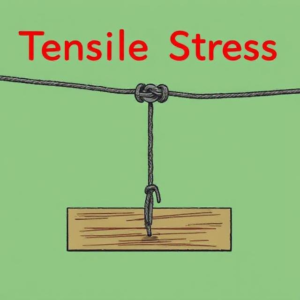Tensile Stress, Tension, Tension Force, and the Tension Formula explanation:
1. Tensile Stress
- What it is: Tensile stress is a measure of how much force is being applied to stretch or pull a material. It’s the force per unit area within materials that are being stretched.
- How it works: When a material (like a rope, wire, or metal) is stretched, the atoms or molecules inside it are pulled apart. Tensile stress tells us how much force is being exerted on a certain area of the material.
- Formula for Tensile Stress:
- Force is how much force is pulling on the material (measured in Newtons).
- Area is the cross-sectional area of the material (measured in square meters).
- Example: Imagine pulling a rubber band. The more you pull on it, the more tensile stress it experiences, especially in the area where you’re pulling.

2. Tension
- What it is: Tension is the force that is transmitted through a string, rope, cable, or any other type of flexible connector when it is being pulled.
- How it works: When you pull on a rope, the rope experiences a force called tension. If you pull harder, the tension increases. Tension acts along the length of the material and pulls outward.
- Example: If you tie a rope between two trees and pull on it, both trees experience tension at the points where the rope is attached. The tension force is pulling the rope in both directions.
3. Tension Force
- What it is: Tension force refers to the specific force that is applied to an object through a rope, cable, or any flexible object. It’s the pulling force that the object experiences due to being stretched or pulled.
- How it works: The tension force is the same throughout a rope (if we neglect things like mass and friction). It can be measured as the force that the rope or cable is applying to the object it is connected to. The tension force is always pulling in opposite directions at each end of the rope or cable.
- Example: Imagine a weight hanging from a rope. The rope applies a tension force to hold up the weight. The tension force is equal to the weight of the object, and it’s acting on the rope and pulling it in both directions.
4. Tension Formula
- What it is: The tension formula helps us calculate the amount of force in an object that is under tension, like a rope or string. We can use this formula to find the tension in situations like pulleys, ropes pulling a load, or when a rope is stretched between two points.
- Formula for Tension Force:
where:
- T is the tension in the rope or string (in Newtons),
- m is the mass of the object being suspended (in kilograms),
- g is the acceleration due to gravity (approximately 9.8 m/s² on Earth).
- Example 1: If you hang a 10 kg object from a rope, the tension in the rope is equal to the weight of the object. The weight is calculated as:
So, the tension in the rope is 98 Newtons.
- Example 2: If there’s a pulley system with an object hanging on one side, the tension will depend on the weight of the object and how the pulley system is set up. In some cases, the tension can be split between multiple ropes or cables.
Key Concepts:
- Tensile Stress is about how force is spread over an area when pulling on something.
- Tension refers to the pulling force experienced by a rope, string, or cable.
- Tension Force is the specific force applied to an object through a rope or cable that is being stretched or pulled.
- The Tension Formula helps calculate how much force a rope or cable can apply to hold up an object or resist pulling forces.
Summary:
- When a rope or string is pulled, it experiences tension.
- Tensile stress measures how much force is applied to the material over a specific area.
- The tension force is the pulling force in a rope, and the tension formula helps calculate how much force is needed to pull or hold something.
Understanding these concepts is important in fields like engineering, construction, and even in simple everyday activities like lifting something with a rope!











